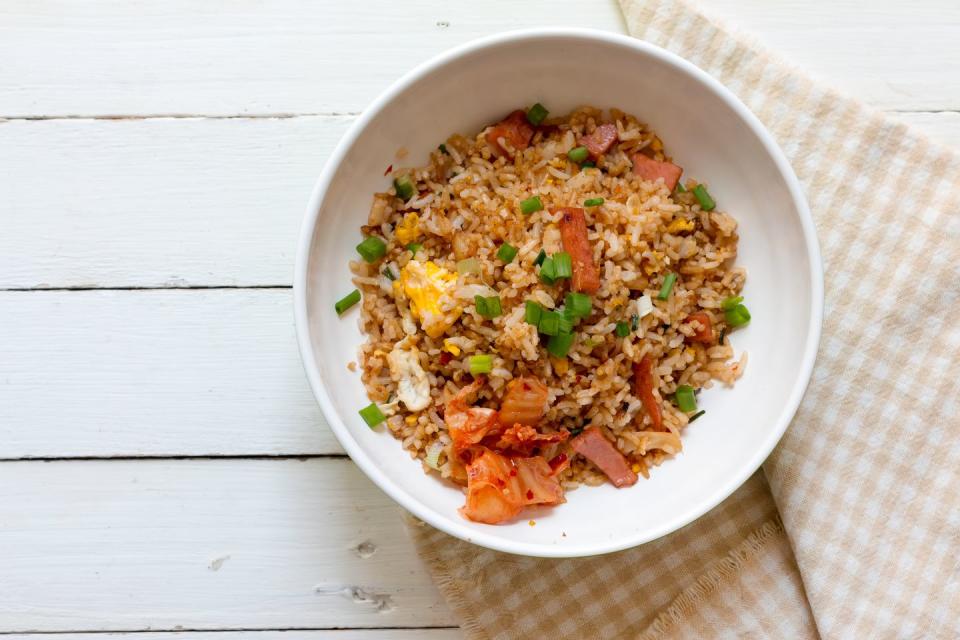Which Rice Is Best for Making Fried Rice?
You can't go wrong with fried rice: Whip up a veggie version, make it meaty, or even serve it for breakfast with a fried egg on top! In leftover rice recipes, it's easy to customize with all of your favorite fixings. (Plus, it's quick to make!)
However, the bottom line is that fried rice is all about the rice itself. Read on to find out the best rice for fried rice—your choice can make all the difference. Then once you have your rice picked out, scroll down for cooking tips and tricks!

Which rice is best for fried rice?
Pick a medium-grain white rice, which is the standard in Chinese cuisine. A fresh batch of this variety turns out sticky in your rice cooker, which makes it easy to eat with chopsticks, yet it also has the ability to separate into individual grains. (Don't go with rice labeled "glutinous rice," however—this is a different variety beloved for its exceptional stickiness, making it ideal for use as a stuffing.) Medium-grain white rice is also generally mild in flavor, so it's perfect for flavoring with mix-ins and other sauces. Note that jasmine rice, a Thai staple, is a medium- to long-grain white rice, but it is slightly floral in aroma. It's still a great choice for fried rice—it just has more personality.
Another good option for fried rice is Japanese-style sushi rice, which is a short-grain sticky rice. When used to make fried rice, it may stir-fry into clumps because it's so starchy; it will also be chewier in texture compared to the drier, crunchier texture of standard takeout fried rice.
If you're wondering, "how long does rice last?" Consider this: cooled fresh rice or day-old rice are your best bet for fried rice. You want the moisture to have evaporated from the rice—that way the grains will crisp up without getting mushy or breaking apart.
Is basmati or jasmine rice better for fried rice?
Though both rice varieties are both good for fried rice, there are differences in texture, size and flavor. Jasmine rice, of Thai origin, is a shorter grain than basmati rice, which is of Indian/Pakistani origin. Both rices are beloved for their fragrant aromas and flavors. Jasmine rice cooks up stickier, in clumps, whereas basmati rice tends to cook up as dry, individual grains that do not stick together.
When used to make fried rice, jasmine rice may beat out basmati rice because of its ability to crisp up without breakage. Because basmati is a longer, drier, less starchy grain, it tends to break when stir-fried.
One other characteristic to keep in mind is that both rices are not totally neutral in flavor and aroma. You may want to choose complementary sauces or mix-ins—look to their cuisines of origin for inspiration.
What is the secret to good fried rice?
If you're cooking fried rice at home, try these helpful tips!
Crank up the heat.
If the heat isn't high enough, you're not frying the rice—you're just reheating the rice.
Break it up.
Before you add the rice to the pan, break up any clumps of rice. You don't want to waste time trying to break it up in the pan, which could lead to uneven cooking or mushiness.
Prep all the mix-ins.
Fried rice cooks quickly, so have everything ready to go to keep ingredients from drying out, burning or becoming overcooked.
Stir-fry in small batches.
This is particularly important when making a large batch of fried rice, as it ensures that each grain of rice has room to actually fry. You want to prevent self-steaming, which causes mushiness. Once everything's been stir-fried as desired, toss it all together again in the pan or in a large bowl.
Go easy on any sauces.
Don't undo all the crispness from stir-frying by drenching the fried rice with sauce (this may also cause the dish to self-steam).

